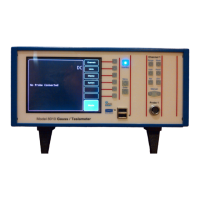F.W. BELL 8000 Series Gauss/Tesla Meter Instruction Manual
Section 1 – Introduction 1-3
General
Description
The Model 8000 Series Gauss/Tesla meters utilize Hall effect probes to
measure magnetic flux density in units of Gauss (G), Tesla (T), Amp/meter
(A/m), or Oersted (Oe). Either steady-state (DC) or alternating (AC) fields may
be measured. Fields as low as 10 µGauss (0.001 µT) or as high as 300k
Gauss (30 Tesla), at frequencies up to 50 kHz, can be measured with extreme
accuracy and 5-3/4 digit resolution. Each channel is calibrated and linearized
independently from data stored within the probes and meters. With a
temperature compensated Hall probe, the instrument can also compensate for
errors due to variations in probe temperature.
User Interface
The meters feature a WVGA, 600x480 pixel, TFT Color LCD Display with
backlighting. The display format may be customized by the operator and the
meter automatically adjusts text sizes for the most convenient view of the
information displayed.
Common functions are activated quickly through the front panel keypad, with
each channel having its own identical set of keys. In addition each key has a
back-light that is illuminated to indicate that it is active.
Less commonly used functions are easily accessible through the menu system.
Auto Range
Four measurement ranges may be selected manually or the instrument can
automatically select the best range based on the present flux density level being
measured.
Zero
The “zero” function allows the user to remove undesirable readings from nearby
magnetic fields (including earth’s) as well as to remove initial electrical offsets in
the probe and instrument. A “zero flux chamber” is included as an accessory
which shields the probe from external magnetic fields during this operation.
Hold
When the hold function is enabled the instrument will “hold” and display the
highest and/or lowest flux density readings that have been measured. Hold
features include capturing peaks and valleys of rapidly changing pulses as well
as arithmetically calculated max and min of slower changing signals.

